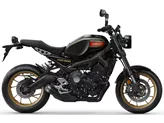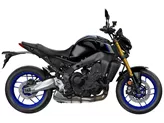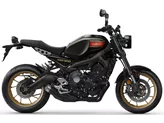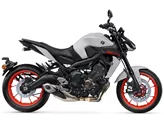Yamaha XSR900 2018 vs. Yamaha R1 2019

Yamaha XSR900 2018

Yamaha R1 2019
Overview - Yamaha XSR900 2018 vs Yamaha R1 2019
The Yamaha XSR900 2018 and the Yamaha R1 2019 are both impressive motorcycles, but they have some notable differences.
In terms of engine specifications, the XSR900 has a 847cc engine with a bore of 78mm and a stroke of 59.1mm. It produces 115 horsepower and 87.5 Nm of torque, with a compression ratio of 11.5. On the other hand, the R1 has a larger 998cc engine with a bore of 79mm and a stroke of 50.9mm. It delivers a whopping 200 horsepower and 112.4 Nm of torque, with a higher compression ratio of 13.
Both bikes feature a DOHC valve system and liquid cooling, ensuring optimal performance. The XSR900 has a 3-cylinder engine, while the R1 has a 4-cylinder engine.

Yamaha XSR900 2018
In terms of suspension, both bikes feature upside-down telescopic forks at the front. The XSR900 has a twin-tube aluminum frame, while the R1 features a Deltabox aluminum frame, which is known for its rigidity and stability.
Braking systems are similar, with both bikes equipped with double disk brakes at the front. The XSR900 features advanced rider assistance systems such as ABS, while the R1 takes it a step further with additional features like launch control and traction control.
In terms of dimensions and weights, the XSR900 has a wheelbase of 1440mm and a seat height of 815mm. It weighs 191kg (with ABS) and has a fuel tank capacity of 14 liters. On the other hand, the R1 has a slightly shorter wheelbase of 1405mm and a higher seat height of 855mm. It weighs 199kg (with ABS) and has a larger fuel tank capacity of 17 liters.

Yamaha R1 2019
When it comes to strengths, the XSR900 is praised for its extremely sporty and rev-happy engine, excellent brakes, and pleasant seating position. It offers a high-quality workmanship and a good price-performance ratio. The R1, on the other hand, is known for its powerful engine, clean response, and perfectly tuned electronics. In the right hands, it can be a very fast track bike.
However, both bikes have their weaknesses. The XSR900 has an almost too direct response, which may not suit all riders. Additionally, some feel that the retro style of the XSR900 is not thought through to the last detail. On the other hand, the ABS system on the R1 is not considered 100 percent satisfactory by some riders.
In conclusion, the Yamaha XSR900 2018 and the Yamaha R1 2019 are both impressive motorcycles, each with their own strengths and weaknesses. The XSR900 offers a more balanced and comfortable riding experience, while the R1 is a high-performance track-focused machine. Ultimately, the choice between the two will depend on the rider's preferences and intended use of the bike.
Technical Specifications Yamaha XSR900 2018 compared to Yamaha R1 2019
Pros and Cons in comparison
Pros and Cons in comparison
Yamaha XSR900 2018

The Yamaha XSR900 is a classic optical illusion - with its round headlight, angular tank and attached tail light, it clearly passes for a retro bike. But it's no coincidence that the performance is reminiscent of the potent mid-range naked bike Yamaha MT-09, which is the extremely sporty basis for the XSR900. So the engine is a blast and the brakes are appropriately venomous. Fortunately, the engineers didn't overdo it with the chassis, the XSR900 offers sufficient comfort and the upright riding position is more comfortable than the powerful engine would lead one to expect. All in all, the XSR900 is one of the sportiest models among the retro bikes.
Yamaha R1 2019

The 2020 R1 model - already available from September - is an evolutionary step that will benefit both the trackday racer and the Yamaha SBK team. The amateur is most likely to benefit from the truly perfect electronics and will also appreciate a little extra power.
Price Comparison Avarage Market Price Yamaha XSR900 vs Yamaha R1
There are a few key differences between a Yamaha XSR900 2018 and a Yamaha R1 2019. There are the same number of bikes of both models available on the 1000PS.de marketplace, specifically 4. It takes less time to sell a Yamaha R1 with 112 days compared to 123 days for the Yamaha XSR900. Since model year 2016 1000PS.de editors have written 30 reviews for the Yamaha XSR900 and 80 reviews for the Yamaha R1 since model year 2005. The first review for the Yamaha XSR900 was published on 25/11/2015 and now has more than 17,600 views. This compares to more than 3,900 views for the first review on Yamaha R1 published on 28/04/2003.
























